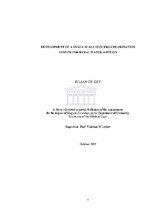| dc.description.abstract | To address the urgent need for safe potable water in South Africa’s rural areas,
sustainable systems for water disinfection at the village-scale of operation are required.In this thesis, the development of a small-scale water chlorination system that runs on salt and solar panels is described. The system combines a membrane-based hypochlorite generator, or “membrane electrolyser”, with an automated hypochlorite dosing system.The system was designed to (i) coordinate hypochlorite production and dosing automatically in a flow-through system, and (ii) fit inline with low pressure pipelines from overhead storage tanks or raised water sources. Low cost materials were used for construction, and water-powered mechanisms were devised to control both brine supply to the electrolyser and regulation of water flow. The capacity of the system was based on the maximum daily output of the electrolyser at ~20 g of sodium hypochlorite. This was sufficient chlorinate up to 10 kL of water per day using less than 80 g of salt and less than 0.1 kW.h of electricity. The cost of the system was estimated at ~R10 000 and
therefore potentially affordable for communities up to 100 people, e.g. small farms and villages.Testing of the system was carried out at a farm site in Worcester (Western Cape) using remote monitoring of current levels in the electrolyser. Operation of the system over a two month test period, dosing at ~4 mg/L, produced consistent chlorination measured as(FAC). Community participation in maintenance of the brine supply was managed and chlorinated water was made available to the community after a brief social survey was conducted. Community awareness of chlorination was minimal. No significant history of diarrhoea was reported. However, the community regularly boiled their tap water in response to turbidity increase in summer.The system was affected by turbidity increase in the local water, which caused a drop in electrolyser current and chlorine production due to particle blockage of the membrane in the electrolyser. However, turbidity at acceptable levels for chlorination was found to have no detrimental effect on the system’s performance. The system showed promise for rural implementation providing low turbidity was maintained. Therefore,groundwater sites, and surface waters with appropriate clarification systems are recommended for the system’s installation. Further testing of the system will be required to establish its long term viability in the hands of a rural community. | en_US |

